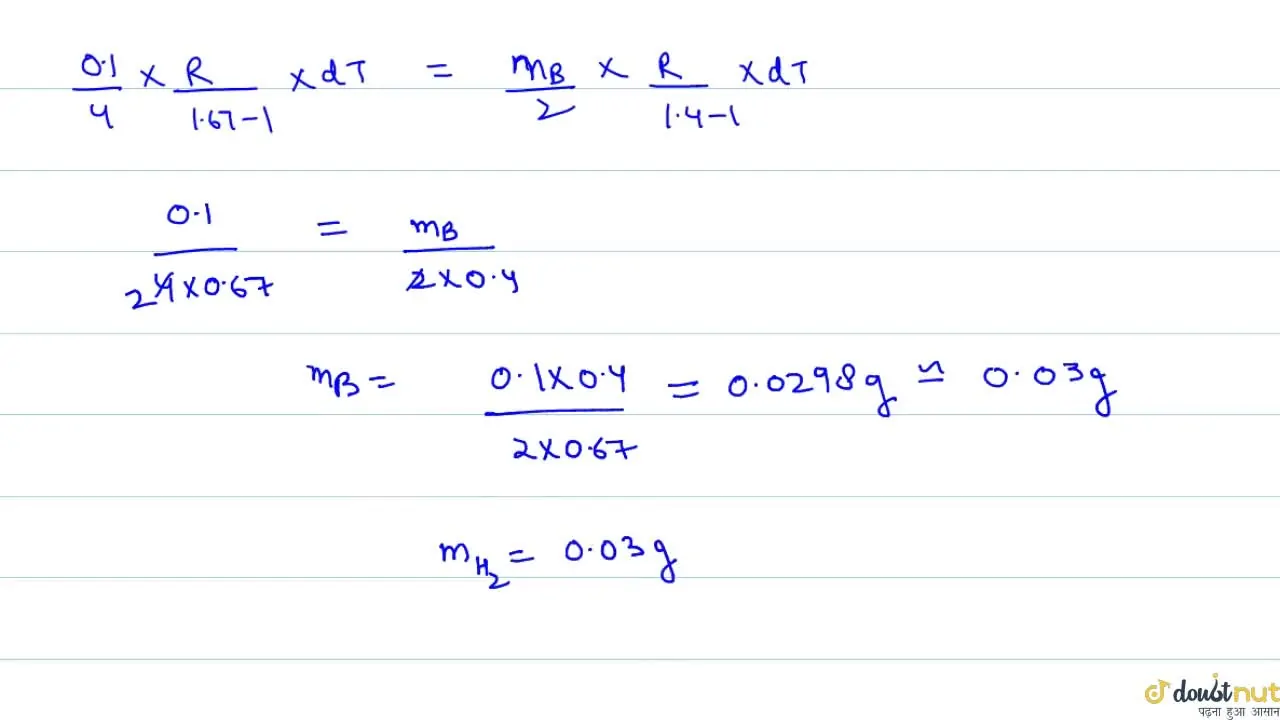Figure shows two vessels with adiabatic walls, one containing 0.1 g of helium (γ=1.67,M=4gmol−1) and the other containing some amount of hydrogen (γ=1.4,M=2gmol−1). Initially , the temperatures of the two gases are equal. The gases electrically heated for some time during which equal amounts of heat are given to the gases. It is found that the temperatures rise through the same amount in the two vessels. Calculate the mass of hydrogen.

mHe=0.1 g,
γ1=1.67, MHe=4g/mol.
MH2=?, MH2=2g/mol,
γ2=1.4
Since it is an adiabatic surroundings
For He, dQ=nCvdT
=m2×Rγ−1×dT
0.14×R1.67−1×dT
For H2 , dQ=nCvdT
=m2×Rγ−1×dT
m2×R1.4−1×dT
[where m is the required mass of H2.] Since equal amount of heat is given to both, so, dQ is same in both Equations ...
(i) and ... (ii), we get
0.14×R0.67×dT
=m2×R0.4×dT
implies m=0.12×0.40.67
=0.0298=0.03g.
Related Playlists
Similar Questions
Equal masses of oxygen and helium gases are supplied equal amount of heat. Which gas will undergo a greater temperature rise and why?
View SolutionThere are two thermally insulated vessel.One with 0.025 moles of helium and other with n moles of hydrogen.Initially both the gases are at room temperature.Now equal amount of heat is supplied to both the vessels. It is found that in both the gases temperature rises by same amount. Find the number of moles of hydrogen in second vessel.
View SolutionTwo identical vessels contain helium and hydrogen gases at same temperature, then
View SolutionFreundlich equation for adsorption of gases (in amount of Xg) on a solid (in amount od mg) at constant temperature can be expressed as
View SolutionFreundlich equation for adsorption of gases (in amount of x g) on a solid (in amount of m g) at constant temperature can be expressed as
View SolutionTwo vessels separately contain two ideal gases A and B at the same temperature, the pressure of A being twice that of B. Under such conditions, the density of A is found to be 1.5 times the density of B. The ratio of molecular weight of A and B is
View SolutionA mixture of gases contains H2andO2 gases in the ratio of 1 : 4 (w/w). What is the molar ratio of the two gases in the mixture?
View SolutionThe amount of heat energy required to raise the temperature of 1 g of Helium at NTP, from T1 K to T2 K is :
View SolutionThe amount of heat energy required to raise the temperature of 1g of Helium at NTP, from T1K to T2K is
View SolutionIn two vessels of 1 litre each at athe same temperature 1g of H2 and 1g of CH4 are taken. For these gases:
View Solution


